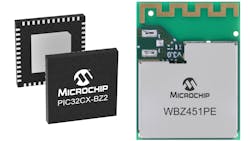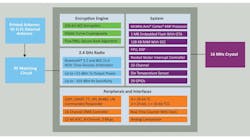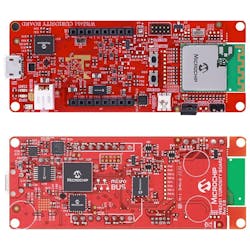Multiprotocol MCU Zeros in on Wireless IoT
What you’ll learn
- What is the PIC32 family?
- How the PIC32CX-BZ2 fits in Microchip’s PIC32 lineu.p
- How it handles multiple wireless protocols.
Check out the other 2023 IDEA Award Nominees.
Microchip’s PIC32 family is a mixed bag of processor architectures brought together by a unified IDE and peripheral set. To most embedded developers who write their code in C or C++, this family looks to be a single platform supported by the MPLAB Harmony V3 framework, which handles multiple communication protocols that the chips work with. The PIC32 family encompasses 32-bit cores including MIP32, Arm Cortex-M0+, and the latest Arm Cortex-M23+.
The PCI32CX-BZ2, the newest addition to the family, is based on a 64-MHz, Arm Cortex-M4F (Fig. 1). The WBZ451 module that uses this chip is available with a printed or external antenna. The chip supports Bluetooth Low Energy 5.2 and 802.15.4, including Zigbee 3.0. The PIC32CX-BZ2, housed in a 48-pin, 7- × 7-mm package, is AEC-Q100 Grade 1 qualified up to 125°C. The WBZ451 has global regulatory certification.
Inside the PIC32CX-BZ2, the Cortex-M4F has access to hardware encryption that includes a random number generator (Fig. 2). There’s 1 MB of embedded flash and its 128 kB of RAM has ECC support. Other peripheral interfaces include QSPI, USART, I2C, SPI, RS-485, and LIN with commander/responder support. There’s an 8-channel, 2-Msample/s 12-bit ADC and an analog comparator on-chip.
PIC32CX-BZ2 and WBZ451 Curiosity Development Board provides a quick way to get started with the chip (Fig. 3). The WBZ451 module has a printed antenna. The board adds a 64-Mb SQPI flash memory, temperature sensor, current measurement header, RGB LED, and a MikroElectronika mikroBUS socket to the mix. It can be powered by a LiPo battery or USB port. There’s also on-board charging support for the battery.
The ability to handle two protocols is useful for IoT applications these days, as Bluetooth is often used to configure and manage devices that are part of an 802.15.4-based network.




